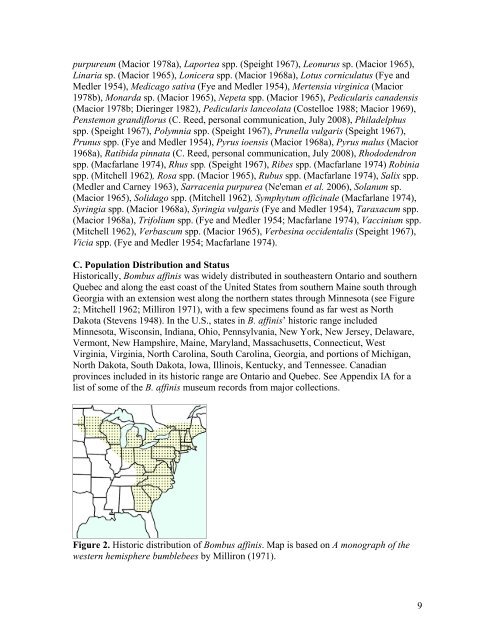and with black hairs extending rearward in a narrow V that partially bisects the yellow onthe scutellum. The second abdominal segment has a rusty reddish patch centrally, withyellow hairs around the edges <strong>of</strong> the segment. See figure 1 for illustrations <strong>of</strong> B. affinisqueen, worker and male.Figure 1. Illustrations <strong>of</strong> Bombus affinis queen (left), worker (center), and male (right) byElaine Evans.Males:Bombus affinis males are 13 to 17.5 mm in length with a breadth <strong>of</strong> 5 to 7 mm (Mitchell1962). Their hair is largely black on the head, but with a few pale hairs intermixed nearthe top <strong>of</strong> the head. Black hairs sometimes form an obscure band across the middle <strong>of</strong> thethorax, otherwise the hair on the thorax is largely pale yellowish. The first two abdominalsegments have pale yellow hair. The hair on the rest <strong>of</strong> the abdominal segments is black.B. Pollination EcologyBombus affinis has been shown to be an excellent pollinator <strong>of</strong> cranberry (Cane andSchiffauer 2003). They have also been shown to pollinate other important crops such asplum and apple (Medler and Carney 1963; Mitchell 1962), alfalfa (Holm 1966), andonion for seed production (Caron et al. 1975).Bombus affinis visits a wide variety <strong>of</strong> wild plants including Abelia grandiflora (Speight1967), Aesculus spp. (Dieringer 1982; Macfarlane 1974), Agastache foeniculum (C.Reed, personal communication, July 2008), Amorpha canadense (C. Reed, personalcommunication, July 2008), Asclepias syriaca, A. incarnata, A. verticillata (Frost 1965;Macior 1965), Aralia spp. (Mitchell 1962), Aster spp. (Costelloe 1988), Aquilegiacanadensis (Macior 1978a), Aureolaria pedicularia (Stiles 1977), Berberis spp. (Macior1965), Camassia scilloides (Macior 1978b), Carduus sp. (Macior 1965), Ceanothusamericanus (Bequaert 1920), Cercis canadensis (Fye and Medler 1954), Chamaedaphnecalyculata (Judd 1966), Coreopsis major (Speight 1967), Crataegus spp. (Macior 1968a),Dalea purpurea (C. Reed, personal communication, July 2008), Delphinium tricorne(Macior 1975), Dicentra canadensis, D. cucullaria (Macior 1978b), Echium vulgare(Macfarlane 1974), Helianthus spp. (Fye and Medler 1954; Colla and Packer 2008),Hydrangea spp. (Mitchell 1962), Hydrophyllum spp. (Macior 1978b, Macfarlane 1974),Impatiens capensis (R. Gegear, personal communication, May 2008), Lamium8
purpureum (Macior 1978a), Laportea spp. (Speight 1967), Leonurus sp. (Macior 1965),Linaria sp. (Macior 1965), Lonicera spp. (Macior 1968a), Lotus corniculatus (Fye andMedler 1954), Medicago sativa (Fye and Medler 1954), Mertensia virginica (Macior1978b), Monarda sp. (Macior 1965), Nepeta spp. (Macior 1965), Pedicularis canadensis(Macior 1978b; Dieringer 1982), Pedicularis lanceolata (Costelloe 1988; Macior 1969),Penstemon grandiflorus (C. Reed, personal communication, July 2008), Philadelphusspp. (Speight 1967), Polymnia spp. (Speight 1967), Prunella vulgaris (Speight 1967),Prunus spp. (Fye and Medler 1954), Pyrus ioensis (Macior 1968a), Pyrus malus (Macior1968a), Ratibida pinnata (C. Reed, personal communication, July 2008), Rhododendronspp. (Macfarlane 1974), Rhus spp. (Speight 1967), Ribes spp. (Macfarlane 1974) Robiniaspp. (Mitchell 1962), Rosa spp. (Macior 1965), Rubus spp. (Macfarlane 1974), Salix spp.(Medler and Carney 1963), Sarracenia purpurea (Ne'eman et al. 2006), Solanum sp.(Macior 1965), Solidago spp. (Mitchell 1962), Symphytum <strong>of</strong>ficinale (Macfarlane 1974),Syringia spp. (Macior 1968a), Syringia vulgaris (Fye and Medler 1954), Taraxacum spp.(Macior 1968a), Trifolium spp. (Fye and Medler 1954; Macfarlane 1974), Vaccinium spp.(Mitchell 1962), Verbascum spp. (Macior 1965), Verbesina occidentalis (Speight 1967),Vicia spp. (Fye and Medler 1954; Macfarlane 1974).C. Population Distribution and <strong>Status</strong>Historically, Bombus affinis was widely distributed in southeastern Ontario and southernQuebec and along the east coast <strong>of</strong> the United States from southern Maine south throughGeorgia with an extension west along the northern states through Minnesota (see Figure2; Mitchell 1962; Milliron 1971), with a few specimens found as far west as NorthDakota (Stevens 1948). In the U.S., states in B. affinis’ historic range includedMinnesota, Wisconsin, Indiana, Ohio, Pennsylvania, New York, New Jersey, Delaware,Vermont, New Hampshire, Maine, Maryland, Massachusetts, Connecticut, WestVirginia, Virginia, North Carolina, South Carolina, Georgia, and portions <strong>of</strong> Michigan,North Dakota, South Dakota, Iowa, Illinois, Kentucky, and Tennessee. Canadianprovinces included in its historic range are Ontario and Quebec. See Appendix IA for alist <strong>of</strong> some <strong>of</strong> the B. affinis museum records from major collections.Figure 2. Historic distribution <strong>of</strong> Bombus affinis. Map is based on A monograph <strong>of</strong> thewestern hemisphere bumblebees by Milliron (1971).9
- Page 1 and 2: Status Review of Three Formerly Com
- Page 4 and 5: use as commercial pollinators. Dr.
- Page 6 and 7: B. Habitat requirementsB. affinis,
- Page 10 and 11: Although this species was formerly
- Page 12 and 13: September 2007).RegionSouthernOntar
- Page 14 and 15: B. Pollination EcologyBombus terric
- Page 16 and 17: as recently as 2007, Massachusetts
- Page 18 and 19: Variety 1: As nominate form above,
- Page 20 and 21: the Rocky Mountains. Below are find
- Page 22 and 23: Historical records from within San
- Page 24 and 25: VI. CURRENT AND POTENTIAL THREATS -
- Page 26 and 27: impatiens to be transported into th
- Page 28 and 29: equest is made to APHIS, APHIS will
- Page 30 and 31: Insecticides are used in wild lands
- Page 32 and 33: eetles use commercial honey bee col
- Page 34 and 35: diseases by the commercial bumble b
- Page 36 and 37: Brown, M. J. F., R. Schmid-Hempel,
- Page 38 and 39: Fitzpatrick, U., T. E. Murray, R. J
- Page 40 and 41: Holm, S. N. 1966. The utilization a
- Page 42 and 43: Leonard, M. D. 1928. A list of the
- Page 44 and 45: Medler, J. T. and D. W. Carney. 196
- Page 46 and 47: Plowright, R. C., B. A. Pendrel, an
- Page 48 and 49: 48: 543-548.Stephen, W. P. 1957. Bu
- Page 50 and 51: Williams, P. H., M. B. Arau ́jo, a
- Page 52 and 53: Abbreviations for museums are as fo
- Page 54 and 55: Tennessee: Sugarlands, 12-Apr-1949,
- Page 56 and 57: H.C. Manis, Strange, U of ID; 2: Bu
- Page 58 and 59:
Montrose, 5-Aug-1960, F., P., & M.
- Page 60 and 61:
Lick Cr. 28 mi SE Union 4280 ft, 3-
- Page 62 and 63:
N.E. Woodley, Strange, WSU; Richlan
















